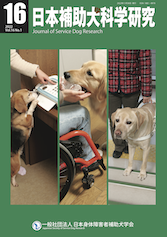Volume 16, Issue 1
Displaying 1-15 of 15 articles from this issue
- |<
- <
- 1
- >
- >|
-
2022Volume 16Issue 1 Pages 2-11
Published: December 05, 2022
Released on J-STAGE: January 08, 2023
Download PDF (2108K)
-
2022Volume 16Issue 1 Pages 12-21
Published: December 05, 2022
Released on J-STAGE: January 08, 2023
Download PDF (4164K)
-
2022Volume 16Issue 1 Pages 22-25
Published: December 05, 2022
Released on J-STAGE: January 08, 2023
Download PDF (1201K) -
2022Volume 16Issue 1 Pages 26-28
Published: December 05, 2022
Released on J-STAGE: January 08, 2023
Download PDF (3009K) -
2022Volume 16Issue 1 Pages 29-31
Published: December 05, 2022
Released on J-STAGE: January 08, 2023
Download PDF (2878K) -
2022Volume 16Issue 1 Pages 32-36
Published: December 05, 2022
Released on J-STAGE: January 08, 2023
Download PDF (1770K) -
2022Volume 16Issue 1 Pages 37-40
Published: December 05, 2022
Released on J-STAGE: January 08, 2023
Download PDF (2457K) -
2022Volume 16Issue 1 Pages 41-43
Published: December 05, 2022
Released on J-STAGE: January 08, 2023
Download PDF (815K) -
2022Volume 16Issue 1 Pages 44-48
Published: December 05, 2022
Released on J-STAGE: January 08, 2023
Download PDF (1664K) -
2022Volume 16Issue 1 Pages 49-52
Published: December 05, 2022
Released on J-STAGE: January 08, 2023
Download PDF (1714K)
review article
-
Article type: review article
2022Volume 16Issue 1 Pages 53-59
Published: December 05, 2022
Released on J-STAGE: January 08, 2023
Download PDF (960K)
original article
-
Article type: original article
2022Volume 16Issue 1 Pages 60-66
Published: December 05, 2022
Released on J-STAGE: January 08, 2023
Download PDF (1045K) -
Article type: original article
2022Volume 16Issue 1 Pages 67-73
Published: December 05, 2022
Released on J-STAGE: January 08, 2023
Download PDF (1085K) -
Article type: original article
2022Volume 16Issue 1 Pages 74-81
Published: December 05, 2022
Released on J-STAGE: January 08, 2023
Download PDF (1100K)
-
2022Volume 16Issue 1 Pages 82-86
Published: December 05, 2022
Released on J-STAGE: January 08, 2023
Download PDF (1578K)
- |<
- <
- 1
- >
- >|
